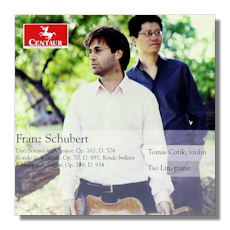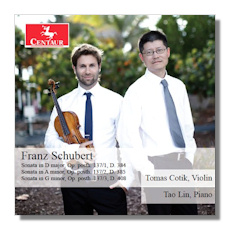
The Internet's Premier Classical Music Source
Related Links
- Schubert Reviews
- Latest Reviews
- More Reviews
-
By Composer
-
Collections
DVD & Blu-ray
Books
Concert Reviews
Articles/Interviews
Software
Audio
Search Amazon
Recommended Links
Site News
 CD Review
CD Review
Franz Schubert

Complete Works for Violin & Piano
Volume 1
- Duo Sonata in A Major, D. 574 (Op. 162)
- Rondo in B minor "Rondo brilliant", D. 895 (Op. 70)
- Fantasy in C Major, D. 934 (Op. 159)
Tomas Cotik, violin
Tao Lin, piano
Centaur CRC3250 59:04


Volume 2
- Sonata for Violin & Piano in D Major, D. 384 (Op. 137 #1)
- Sonata for Violin & Piano in A minor, D. 385 (Op. 137 #2)
- Sonata for Violin & Piano in G minor, D. 408 (Op. 137 #3)
Tomas Cotik, violin
Tao Lin, piano
Centaur CRC3412 55:30
These are the first two volumes in this Centaur series that will offer the complete works of Franz Schubert for violin and piano. The team of violinist Tomas Cotik and pianist Tao Lin have received high praise internationally for their Schubert performances, and listening to these discs it's easy to see why: they interpret the music sensitively, with a firm grasp on Schubert's style – or evolving style – and their technical skills are superb. Argentinian-born Tomas Cotik won the 1997 National Broadcast Music Competition in Argentina, and has garnered other important awards and distinctions. He has served as concertmaster of the New World Symphony Orchestra and played in several important chamber ensembles. Chinese-born pianist Tao Lin has performed both as soloist with major orchestras across the globe and chamber musician in such groups as the Berlin and Brahms Piano Quartets. Both Cotik and Lin have made a number of acclaimed recordings, including a recent Naxos disc of works by Ástor Piazzolla.
Cotik plays with a range of color and depth: his attacks are potent and precise, but he can deftly turn elegant or fluent as the mood changes, and his tone in lyrical or softer passages can be creamy but a bit sinewy as well and often with an edge. Lin is generally deferential – wisely so in such repertory – but he knows how and when to be assertive and always plays with an excellent sense for dynamics. Tempos by the two players tend to be centrist, never coming across as extreme or constantly shifting, and both players possess formidable technical skills.
Let me begin with the new disc which contains the three Op. 137 Sonatas, written when Schubert was nineteen years old. They are said to divulge the influence of Mozart and Beethoven, and while that assertion can comfortably be posited, Schubert's voice is still clearly in evidence in virtually every bar of music here. In the D major Sonata (D. 384) Cotik and Lin wisely choose not to seek out profundities that aren't there, but rightly play up the light and youthful nature of the work, the shortest and least ambitious of the three sonatas.
That sense of lightness is dispelled in the A minor (D. 385): the first movement is conflicted and stormy, and the two players capture the more serious character of the music here with a deft sense for drama, a broad range of dynamics and very sensitive phrasing. They are warmly songful in the ensuing Andante and achieve a perfect balance between the violin and piano. The Menuetto is delightful in its playful manner, and Cotik adds a bit of grit to his elegant playing. In the finale the quirky Schubert presents a variety of moods, from the slightly anxious demeanor of the lovely main theme (a typical Schubert theme, despite whatever influences one might discern in this work) to the lighter alternate theme and onto the stormy music that follows. Cotik and Lin convincingly harness the contrasting moods, seamlessly shifting from unsettled elegance to playfulness and then to a fiery and weightier style. An excellent performance!
The same technical and interpretive strengths are evident in the G minor sonata (D. 408). Again, Schubert offers many challenges in the way he can appear light and carefree one moment and then serious or dark the next. Once more the two players are attuned to the demands and emotional character of the music throughout this sonata, which comes across as a sort of cross between the lightness in the D major and the seriousness in the A minor.
The first disc here contains a mixture of early and late works. The Duo Sonata dates to 1817, when Schubert was twenty. One could almost classify this work as middle-period, since Schubert only lived thirty-one years. It already displays maturity and sounds nearly free of stylistic influences. It has an immediately arresting opening, as the piano states a rhythmic motive that you almost expect to develop into a theme itself, but then the violin comes in with a lovely somewhat wistful melody that eventually soars beautifully into the higher regions. Cotik and Lin phrase this music with such feeling, making you wonder if it could possibly sound better in any other performance. They play the more agitated and spirited music that follows with a sense of both anxiousness and elegance, which so perfectly fits Schubert. The whole movement is convincingly rendered, as is the brief Scherzo and Trio: the two players impart both an energetic youthfulness and a sort of muscular gusto as they deftly capture the hearty and joyous character of the music here. The third movement Andantino is subtly charming as Cotik phrases the main theme with an innocence and almost meditative quality that deftly set up the outburst that comes with the emphatic piano chords. When Lin takes up the theme later on he employs just the right amount of legato to maintain the lovely naïve character of the music. The finale bristles with energy and joy, the violin and piano going busily in different directions or by turns seizing the foreground only to step back demurely to yield to the other instrument. Again, a performance to savor!
Cotik and Lin are utterly on target in the more epic Rondo in B minor (D. 895), from 1826: they convincingly harness the grim drama, the dreamy lyricism, the plentiful moments of ecstatic joy, and the final all-conquering sense of triumph. And they do so in gorgeous and technically polished playing. Much the same can be said in summarizing their performance of the 1827 Fantasy in C major (D. 934). Indeed, this is another work whose brilliance, color and ranging moods require a balance of intelligence, feeling and superior technique. All those elements are abundantly in evidence here in this performance. The album notes for both releases are informative and Centaur's sound reproduction is very clear and well balanced in all works.
There have been many great artists who have delved into some of this repertory, from Kreisler and Rachmaninov to the brilliant young Julia Fischer and Martin Helmchen. Overall, these two discs featuring Cotik and Lin must be regarded as among the finest performances for their consistent artistry and idiomatic grasp on Schubert's quirky and wide-ranging style. Highly recommended!
Copyright © 2015, Robert Cummings





















